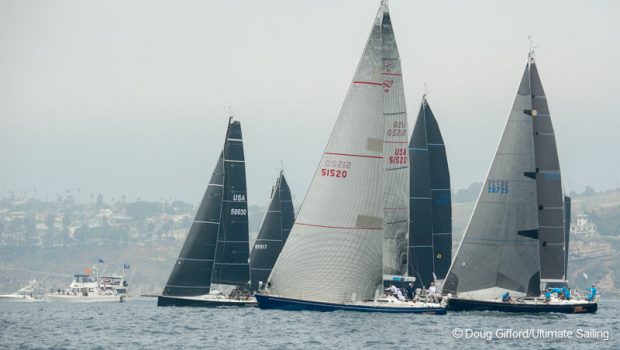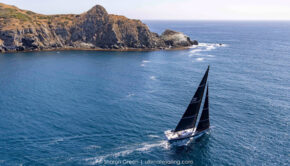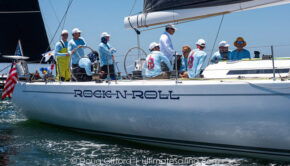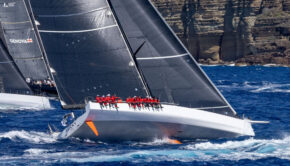Starts continue for 50th Transpac Race
Published on July 12th, 2019
Los Angeles, CA (July 12, 2019) – In gray but clearing skies and a light building seabreeze, the second wave of monohull entries has left the Point Fermin start line to begin the course to the Diamond Head finish line in Honolulu, 2225 nm away in this year’s 50th edition of the Transpacific Yacht Race.
Today 13 yachts in Division 3, 11 in Division 4, and 3 teams in Division 5 set off for their first mark of the course, the West End of Catalina Island, before heading southwest on tracks determined by their navigators to be the right balance between greater wind speed to the south versus shorter distance to the north.
Weather forecasts for the coming days suggest tracks that should sag south, but not quite as far south as the first wave on July 10 was advised. Wind angles and pressures look good for the next few days for this second group.
Among the group one starters, there have been three teams who have encountered problems serious enough to turn back for the coast.
The first was Mark Ashmore’s Cal 40 Nalu V, who reported yesterday: “Difficulties keeping bilge dry, pumps keeping ahead but reason for water ingress unknown, returning to port.” Next was Kyle Vanderspek’s Hobie 33 Aloha, reporting rudder problems, and this morning another Hobie 33, Steve Eder’s Mayhem, also with damage to their rudder. Both are returning to port and all aboard these retiring yachts are safe and unhurt.
So far the division leaders are David Gorney’s J/105 No Compromise in Division 8, no doubt because she is furthest north and thus sailing a track closest to the rhumb line and thus the shortest distance relative to the others. At 1700 PDT she was 136 miles north of Cecil and Alyson Rossi’s Farr 57 Ho’okolohe who is leading not only Division 6 but the entire fleet now in shortest distance to Hawaii at 1807 miles.
Other division leaders at this time are Tim Jones’s Olsen 40 Live Wire for Division 6, Michael Yokell’s Oyster 56 Quester in Division 7, Ian Ferguson’s Wasa 55 Nadelos for Division 9, and Lior Elazary’s Lagoon 400S2 Celestra in Multihull 0A.
Over the next 8-14 days the second wave fleet that left today and the first wave that left July 10 will face all the pros and cons inherent to ocean racing: these range from being miserably cold, wet, uncomfortable, tired and bored for hours on end to seeing the glory of brilliant sunrises and sunsets leading to and from star-filled nights, seeing sea life in, on and over the water, having the weather get warmer and the wind go aft a little more every day, and looking forward every morning to the daily position reports to see their progress towards Hawaii but also how they’re positioned relative to their competitors on the course.
And for the next few days, as faster boats start overtaking the slower boats, there will be the occasional thrill of a visual contact made with a running light at night, a silhouette at dawn, or a sail plan seen just on the horizon. This is breaking news on a boat at sea, and for a while the crew is focused on this target, armed with binoculars, hand bearing compasses and a lot of speculation on who this could be.
This is the sort of entertainment that has replaced the digital life left behind on the coast, and what drives us to the sea to reconnect with nature and our shipmates. Yet the digital life has not been completely removed on many boats, since tales are coming in to TPYC race headquarters via email that range from facts-only reports that read like log entries to some quite amusing accounts of life on board. For example, take this from Celestra’s morning report:
“Flying a Code 0 and main. Things have been a bit difficult on Celestra. First my steak was over done after I specifically asked for medium rare, and then our projector bulb went out. So much for movie night (and people said it would be easy on a cruising catamaran). Over all the sailing is good, with a consistent 15-18kts true wind with 3-4 ft waves. However, we all wish we knew what to do with these large white clothes flapping in the wind. The thing that makes this somewhat bearable is ice cream sandwiches and the fact that we are crossing an ocean as part of the Transpac 🙂 Thank you for putting on such a great event.”
Another from one of the smallest boats in the fleet being double-handed by Charles Devanneaux and Fred Courouble is Devanneaux’s new Figaro 3 A Fond Le Girafon, who say:
“Cold and still wet outside…a bit of drizzle…seems like home in Brittany…waiting for the sun to dry the boat [and] the jackets. The baby giraffe (girafon) is a wet animal on the deck, spinnaker is up… going to Hawaii now. Let’s get Mai-Tai’s ready.”
Daily standings from 0800 roll call: click here.
Event Details – Entry list – Tracker – Facebook
Note: There is a 4-hour delay on the tracker but goes live within the final 200 miles.
Background: First organized by the Transpacific Yacht Club in 1906, the biennial Transpacific Yacht Race or Transpac is an offshore sailing race from Point Fermin in Los Angeles to Diamond Head, just east of Honolulu, a distance of 2225 nm. The 2019 edition has 12 divisions with staggered starts on July 10, 12, and 13.
Boats racing in Divisions 6, 7, 8, 9, the Cal 40s, and the Multihulls in Class 0A will start on July 10. The second start on July 12 will be for the boats in Divisions 3, 5 and the Santa Cruz 50/52s, with the final start on July 13 for the remaining monohull entries in Divisions 1 and 2, along with the Multihull class 0 entries.
Source: TPYC









 We’ll keep your information safe.
We’ll keep your information safe.